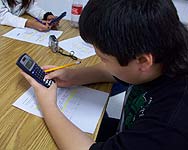Watts Up With School Energy?
Posted on January 13th, 2009 - 10:30 AMAbout the author: Kelly Leovic manages EPA’s Environmental and Community Outreach Program in Research Triangle Park. Kelly has worked at EPA for 21 years and has three children, one of whom needs regular reminders to “turn the lights off when you leave the room.”
“Raise your hand if you recycle,” I said to 15 students at Lowes Grove Middle School in Durham, NC. It was my first apprenticeship class at Citizen Schools, a national program that partners with middle schools to expand the learning day for low-income children.
The goal of my 10-week Environmental Awareness Apprenticeship was to guide the students in developing an environmental project. No hands were raised in response to my recycling question, so I launched into my “Trash Talk” lesson which, in addition to REDUCE, REUSE, RECYCLE, includes a trash sort activity. The students sorted through bags of “trash” to discover what could be reused, composted, or recycled. They quickly applied their new knowledge of the three R’s and were on their way to environmental awareness.
As the apprenticeship progressed, we learned about water pollution, conservation, and energy. (A few students even admitted taking over 1 hour showers, so we had a little talk about that one!) One day we used Watts meters to measure and compare the energy use of regular light bulbs and compact fluorescents. Equating energy use to money piqued their interest, and the students decided to do their project on measuring the energy use of various school equipment.
 My “apprentices” used a Watts meter to measure computers, printers, microwaves, pencil sharpeners, and projectors during use and when they were turned off but plugged in. Next, the students calculated the estimated annual cost of using the equipment based on 9.86 cents per Kilowatt/hour and multiplied this by the number of each and estimated time used.
My “apprentices” used a Watts meter to measure computers, printers, microwaves, pencil sharpeners, and projectors during use and when they were turned off but plugged in. Next, the students calculated the estimated annual cost of using the equipment based on 9.86 cents per Kilowatt/hour and multiplied this by the number of each and estimated time used.
What suprised us the most was that, based on estimated usage time, the 37 printers at the school actually use more energy when they are plugged in but turned off ($117 annually) than when they are in use ($75 annually). This is because some appliances, e.g., think of a microwave clock, still consume energy just by being plugged in.
I truly enjoyed teaching these kids because they didn’t begin with much environmental knowledge, so I felt I could make a difference in their behaviors and choices. Being a Citizen Teacher also gave me the opportunity to work with the same group of students throughout the semester and to get to know them individually. One of the highlights for the students was their field trip to our EPA Building where they could see EPA’s energy conservation efforts in practice.
In addition to learning about ways to conserve energy at school, the students had an opportunity to “teach” their Principal about what they learned, presenting their results and recommendations for school energy savings at a staff meeting. This is one visit to the Principal’s office that I can feel good about!
Epilogue: On December 9, the students presented their recommendations to over 200 attendees at the Citizen Schools final program. The Principal, the Superintendent of Schools, and a State Senator were there and are excited about implementing the energy saving tips from our middle school citizens.
Tags: Citizen Schools, Energy, environmental awareness, students
| Permalink | TrackBack
January 14th, 2009 at 8:22 am
This is an awesome idea for an environmental topic in young teens and kids, i really believe you may be able to reach them at this level with creative ideas and visuals. It is very important for students to be informed of many environmental issues in today’s world and you have hit bingo with this one Kelly!
[Reply]
January 15th, 2009 at 12:11 pm
Kelly: I use the same trash bag approach with young grade school kids while providing the information on solid waste. I bring door prizes (little things) and kids just love it! I also like to tell them that there is a fourth “R” and that stands for “respond”. Last year I did this trash bag activity with kids from a military base school and they worked with the “Respond R” by writing a letter to the mayor of the town where most of them live about initating a recycling program. They sent me the response from the mayor’s office. Couldn’t be any more proud!
[Reply]